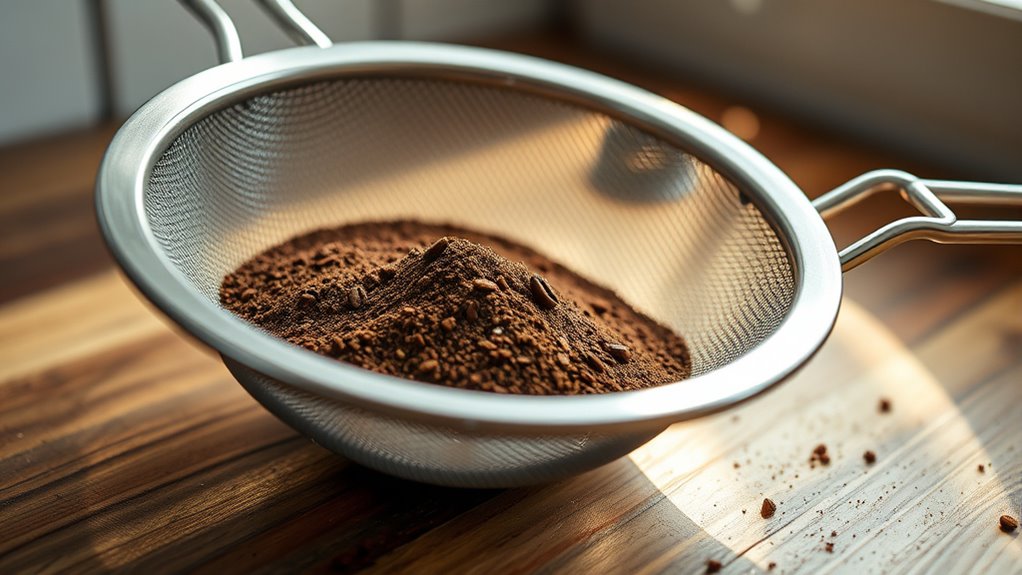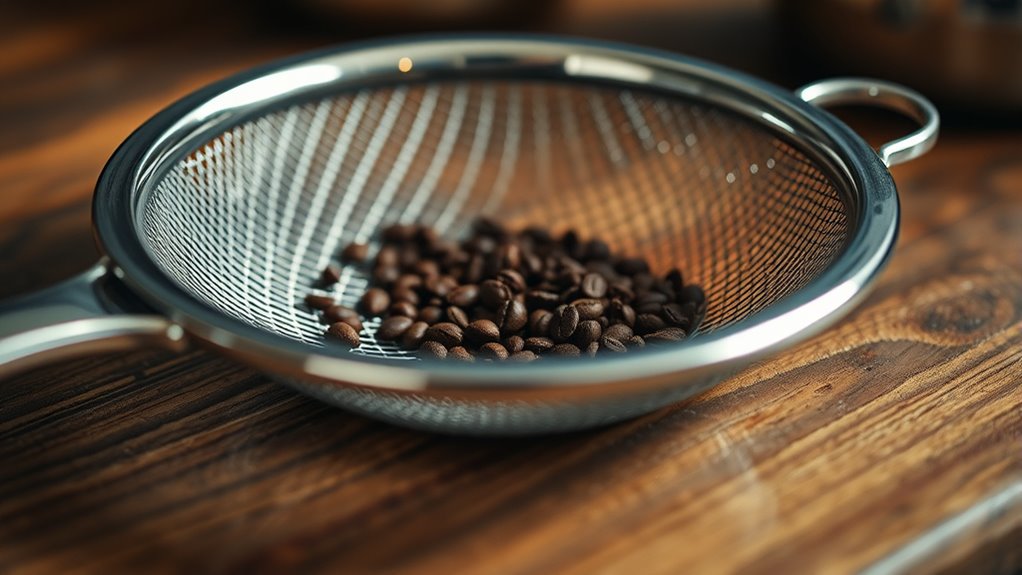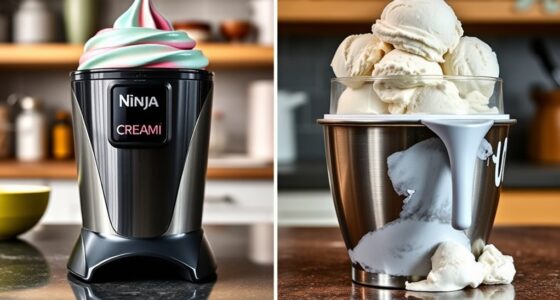Using a coffee sieve helps you achieve smooth, uniform grounds by removing fines and uneven particles. This process promotes better extraction, resulting in cleaner, more balanced flavors in your brew. It also prevents clogging and sediment buildup in your equipment, extending its lifespan. Although it adds a few extra steps, the improved taste and consistency are worth it. Keep exploring to discover how this simple tool can make your coffee experience even better.
Key Takeaways
- Coffee sieves remove fines, ensuring uniform grind size for smoother, more balanced extraction.
- They help prevent over-extraction and bitterness by filtering out tiny coffee particles.
- Using a sieve enhances flavor clarity and consistency in brewed coffee.
- Sieves promote even water contact, leading to a smoother, more refined cup.
- They support precise grind calibration, improving overall brew quality and smoothness.

A coffee sieve is an essential tool for achieving consistent and high-quality brews. It helps you control the size of coffee grounds, ensuring uniform particle distribution that leads to ideal extraction. When you sift your coffee, you remove fines—tiny particles that can cause over-extraction and bitterness—along with larger, uneven particles that might result in under-extraction and sourness. This process enhances flavor clarity by creating a more consistent bed of grounds, which is especially critical when brewing espresso or pour-over methods where precision affects the final taste.
Using a coffee sieve not only improves your brew quality but also benefits your equipment. By filtering out fines, you reduce the risk of filter clogging in espresso machines and prevent sediment buildup in French presses or pour-over devices. This means your equipment stays cleaner longer and performs more reliably. It also extends the lifespan of your grinder’s burrs by compensating for grind inconsistencies, reducing the wear and tear on your equipment.
Filtering out fines keeps your equipment cleaner and more reliable, extending its lifespan and improving overall brewing performance.
Plus, regular sifting minimizes maintenance needs, saving you time and money on repairs or replacements. From a brewing science perspective, a uniform particle size promotes even water contact, enabling more controlled extraction. This evenness prevents channeling—where water bypasses parts of the coffee bed—ensuring your water interacts evenly with all grounds. Additionally, understanding the macronutrient distribution of your coffee grounds can help optimize extraction and flavor profile.
As a result, you can better manage extraction yield percentages, making your brews more repeatable across multiple sessions. For high-volume or commercial settings, a coffee sieve standardizes output quality, reduces waste caused by unpredictable extraction, and supports calibration against grinder profiles. It’s indispensable for baristas aiming for competition-level consistency or maintaining quality assurance in specialty coffee chains.
At home or in DIY setups, a coffee sieve offers a cost-effective way to refine your brew without upgrading to expensive grinders. It allows you to experiment with grind sizes and recipes, helping you achieve the perfect balance and clarity in immersion methods like cold brew. You can also customize particle distributions to suit different filter types, giving you more control over your brewing process.
Most coffee sieves feature multiple interchangeable mesh sizes, typically ranging from 200 to 1200 micrometers, and are stackable for multi-stage sifting. Made from durable, food-grade stainless steel, they’re compact enough to fit comfortably on your workspace.
However, keep in mind that sifting adds a few minutes to your workflow, and you’ll lose some coffee mass (around 5-15%) due to fines removal. Regular cleaning and secondary storage for coarse particles are necessary to maintain effectiveness. While less critical for dark roasts that mask extraction issues, a coffee sieve remains a valuable tool for elevating your brewing precision and consistency.
Frequently Asked Questions
What Materials Are Best for Coffee Sieves?
When choosing materials for coffee sieves, you want durability, corrosion resistance, and flavor preservation. Stainless steel stands out because it’s strong, easy to clean, and doesn’t affect taste.
Copper offers excellent heat conduction but might alter flavors.
Plastic is lightweight and affordable but less durable.
Aluminum is lightweight and resistant to corrosion, while bamboo adds eco-friendliness.
Pick a material that balances performance, longevity, and your budget to guarantee smooth brewing.
How Do I Clean and Maintain Coffee Sieves?
To clean and maintain your sieve, start by rinsing it with warm water after each use to remove coffee oils and particles.
Use a soft sponge and mild soap for regular cleaning, and apply baking soda paste for stubborn stains.
Soak in soapy water occasionally, dry thoroughly, and store in a dry place.
Disassemble if needed, clean all parts, and guarantee everything is dry to prevent mold and keep performance ideal.
Can Coffee Sieves Be Used for Other Beverages?
Sure, coffee sieves are practically begging to be used for other beverages, right? You can try them with tea, herbal infusions, or anything that needs sediment removal or grind uniformity.
Just keep in mind, not all sieves fit every particle size or liquid. So, while they might seem versatile, it’s best to check whether the sieve’s design matches the beverage’s needs—otherwise, you might end up with more mess than magic.
Are There Different Sizes of Coffee Sieves for Specific Brews?
Yes, different sizes of coffee sieves are designed for specific brewing methods. You’ll find finer mesh sizes (35-50) for espresso, which help prevent over-extraction, while coarser sizes (20-30) suit pour-over and drip coffee, removing fines that clog filters.
Larger mesh sizes (12-18) work well for French press, minimizing sediment. Choosing the right sieve size guarantees you get consistent grounds tailored to your brewing method for ideal flavor.
How Do I Choose the Right Sieve Mesh for My Coffee Preference?
To choose the right sieve mesh for your coffee preference, consider your brewing method and desired grind size.
If you prefer espresso, go for finer meshes between 35-50.
For pour-over or drip, medium-fines around 20-30 work best.
Coarser meshes, like 12-18, suit French press or cold brew.
Make sure the sieve is durable, easy to clean, and fits your needs for consistent, flavorful coffee.
Conclusion
Using coffee sieves might seem like extra effort, but they truly make a difference in your brew’s quality. By removing unwanted grounds, you get a smoother, more consistent cup every time. Sure, it’s a small step, but it’s worth it for the perfect flavor. Don’t let the extra minute scare you; once you see the improved taste, you’ll wonder how you ever brewed without one. Give it a try—you’ll love the rich, smooth coffee you create!









